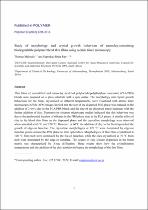 ResearchSpace
ResearchSpace
Study of morphology and crystal growth behaviour of nanoclay-containing biodegradable polymer blend thin films using atomic force microscopy
JavaScript is disabled for your browser. Some features of this site may not work without it.
- ResearchSpace
- →
- Research Publications/Outputs
- →
- Journal Articles
- →
- View Item
| dc.contributor.author |
Malwela, T

|
|
| dc.contributor.author |
Ray, SS

|
|
| dc.date.accessioned | 2012-07-05T08:53:02Z | |
| dc.date.available | 2012-07-05T08:53:02Z | |
| dc.date.issued | 2012-04 | |
| dc.identifier.citation | Malwela, T and Ray, SS. 2012. Study of morphology and crystal growth behaviour of nanoclay-containing biodegradable polymer blend thin films using atomic force microscopy. Polymer, vol. 53(13), pp 2705-2716 | en_US |
| dc.identifier.issn | 0032-3861 | |
| dc.identifier.uri | http://www.sciencedirect.com/science/article/pii/S0032386112003412 | |
| dc.identifier.uri | http://hdl.handle.net/10204/5983 | |
| dc.description | Copyright: 2012 Elsevier. This is the post-print version of the work. The definitive version is published in Polymer, vol. 53(13), pp 2705-2716 | en_US |
| dc.description.abstract | Thin films of unmodified and nanoclay-modified polylactide/poly(butylene succinate) (PLA/PBS) blends were prepared on a glass substrate with a spin coater. The morphology and crystal growth behaviours for the films, crystallized at different temperatures, were visualized with atomic force microscope (AFM). AFM images showed that the size of the dispersed PBS phase was reduced on the addition of 2 wt% clay to the PLA/PBS blend, and the size of the dispersed phase increases with the further addition of clay. Transmission electron microscopy studies indicated that this behaviour was due to the preferential location of silicates in the PBS phase than in the PLA phase. A similar effect of clay to the blend thin films on the dispersed phase and the crystalline morphology were observed when annealed at 60 °C and 120 °C. However, at 60 °C the addition of clay to the blend quenched the growth of edge-on lamellae. The crystalline morphologies at 120 °C were dominated by edge-on lamellae grown around the PBS phase to form spherulites. Morphologies of thinfilms crystallized at 120 °C from melt were dominated by the flat-on lamellae, while the ones crystallized at 70 °C from melt were dominated by the edge-on lamellae. The degree of clay silicate dispersion in the blend matrix was characterized by X-ray diffraction. These results show how the crystallization temperatures and the addition of the clay particles influence the morphology of the thin films. | en_US |
| dc.language.iso | en | en_US |
| dc.publisher | Elsevier | en_US |
| dc.relation.ispartofseries | Workflow;9023 | |
| dc.subject | Clay-containing polymer blends | en_US |
| dc.subject | Morphology | en_US |
| dc.subject | Atomic force microscopy | en_US |
| dc.subject | Polymer blends | en_US |
| dc.subject | Crystallization | en_US |
| dc.title | Study of morphology and crystal growth behaviour of nanoclay-containing biodegradable polymer blend thin films using atomic force microscopy | en_US |
| dc.type | Article | en_US |
| dc.identifier.apacitation | Malwela, T., & Ray, S. (2012). Study of morphology and crystal growth behaviour of nanoclay-containing biodegradable polymer blend thin films using atomic force microscopy. http://hdl.handle.net/10204/5983 | en_ZA |
| dc.identifier.chicagocitation | Malwela, T, and SS Ray "Study of morphology and crystal growth behaviour of nanoclay-containing biodegradable polymer blend thin films using atomic force microscopy." (2012) http://hdl.handle.net/10204/5983 | en_ZA |
| dc.identifier.vancouvercitation | Malwela T, Ray S. Study of morphology and crystal growth behaviour of nanoclay-containing biodegradable polymer blend thin films using atomic force microscopy. 2012; http://hdl.handle.net/10204/5983. | en_ZA |
| dc.identifier.ris | TY - Article AU - Malwela, T AU - Ray, SS AB - Thin films of unmodified and nanoclay-modified polylactide/poly(butylene succinate) (PLA/PBS) blends were prepared on a glass substrate with a spin coater. The morphology and crystal growth behaviours for the films, crystallized at different temperatures, were visualized with atomic force microscope (AFM). AFM images showed that the size of the dispersed PBS phase was reduced on the addition of 2 wt% clay to the PLA/PBS blend, and the size of the dispersed phase increases with the further addition of clay. Transmission electron microscopy studies indicated that this behaviour was due to the preferential location of silicates in the PBS phase than in the PLA phase. A similar effect of clay to the blend thin films on the dispersed phase and the crystalline morphology were observed when annealed at 60 °C and 120 °C. However, at 60 °C the addition of clay to the blend quenched the growth of edge-on lamellae. The crystalline morphologies at 120 °C were dominated by edge-on lamellae grown around the PBS phase to form spherulites. Morphologies of thinfilms crystallized at 120 °C from melt were dominated by the flat-on lamellae, while the ones crystallized at 70 °C from melt were dominated by the edge-on lamellae. The degree of clay silicate dispersion in the blend matrix was characterized by X-ray diffraction. These results show how the crystallization temperatures and the addition of the clay particles influence the morphology of the thin films. DA - 2012-04 DB - ResearchSpace DP - CSIR KW - Clay-containing polymer blends KW - Morphology KW - Atomic force microscopy KW - Polymer blends KW - Crystallization LK - https://researchspace.csir.co.za PY - 2012 SM - 0032-3861 T1 - Study of morphology and crystal growth behaviour of nanoclay-containing biodegradable polymer blend thin films using atomic force microscopy TI - Study of morphology and crystal growth behaviour of nanoclay-containing biodegradable polymer blend thin films using atomic force microscopy UR - http://hdl.handle.net/10204/5983 ER - | en_ZA |





